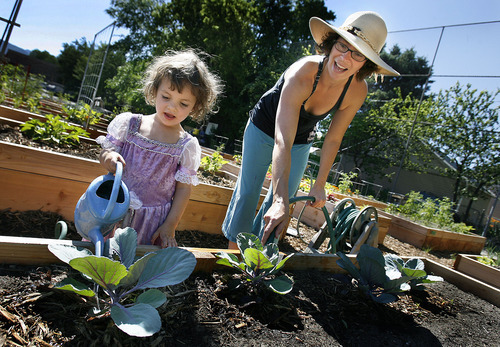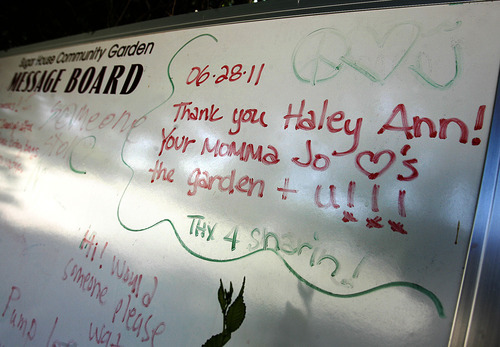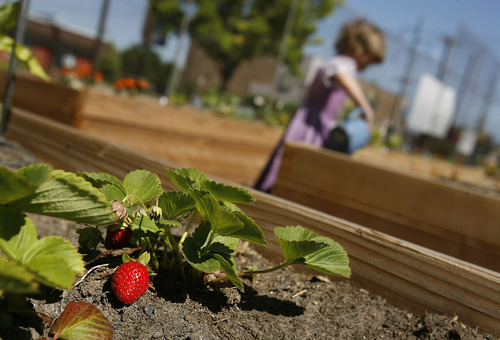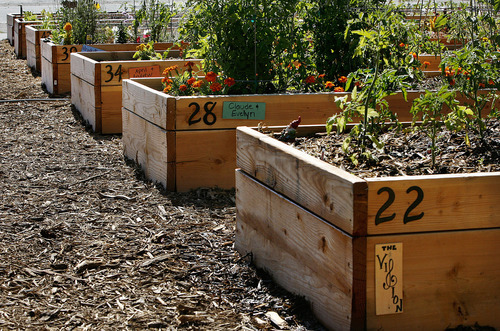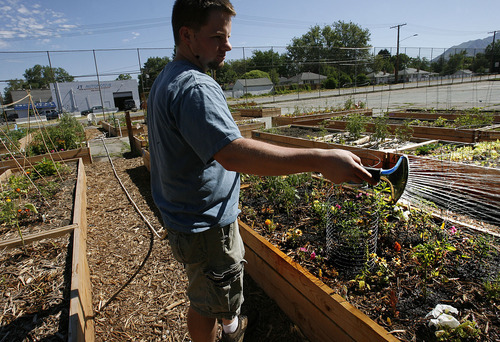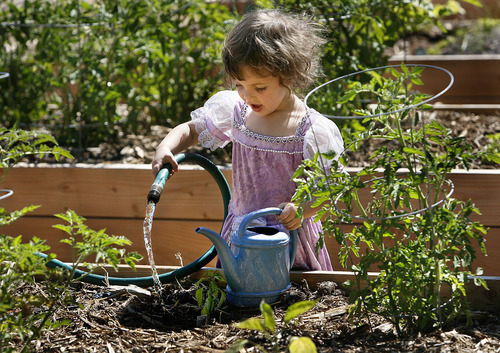This is an archived article that was published on sltrib.com in 2011, and information in the article may be outdated. It is provided only for personal research purposes and may not be reprinted.
Its plants and fertile beds may be temporary, but the Sugar House Community Garden could have a lasting effect on how Salt Lake City treats similar projects in the future.
Neighbors of Fairmont Park's tennis courts at 2225 S. 900 East secured city permission in early spring to place a series of raised garden beds and an irrigation system directly on top of the unused courts.
Now a vibrant spread of green amid concrete, weedy railroad tracks and busy city streets, the Sugar House gardens add to the expanding array of community gardens, farmers markets and backyard cooperatives that make up Salt Lake County's local-food movement.
Spurred by motivated residents, the garden spot now beautifies a portion of Sugar House that the city had ignored for years as it struggled for money to resurface and improve the decaying set of tennis courts adjacent to the Sugar House Boys & Girls Club at Fairmont Park.
Officials also have delayed final land-use decisions for the larger corridor as a planned streetcar line along Sugarmont Drive takes shape.
In that bureaucratic limbo, community organizers waded into the city's complex application process less than a year ago. Now nearly 40 individuals, families and youth groups grow food and flowers on 56 hand-built, mostly 4-by-12-foot organic garden plots, funded through retail-store donations and volunteer labor.
"It's been great to see how many people were interested," said project instigator and area resident Heidi Spence, who, with neighbor Aimee Horman, helped move through City Hall obstacles to make the garden happen.
The first-come, first-serve community garden now has no more space available for the 2011 season, although four beds are set aside for visitors. Demand was high, organizers say, drawn from a densely populated neighborhood where residents forgo private garden space for apartment dwelling, smaller yards, parking spaces and mature trees.
Staked tomato bushes now thrive in direct sunlight that would wither the most hydrated tennis player, as rows of peppers, broccoli, squash, cabbage, cucumber, peas, chard, zucchini, rosemary and basil abound nearby. Urban gardeners sauntered placidly amid the ordered rows one recent Saturday afternoon, entering through open chain-link fences to weed or water their personalized patches.
The garden pumps water from a nearby ditch fed by natural springs and the Fairmont Park duck ponds. Vegetable rows are punctuated by marigolds, lavender, poppies and pansies to attract pollinating insects.
The Sugar House site brings the number of community gardens operating in Salt Lake County to 21, including new gardens in Magna and South Salt Lake brought online this season under the county's urban-farming program. The number of farmers markets county-wide has mushroomed from a handful to more than a dozen in recent years.
The trends are part of a surge in demand for locally produced organic food — born of diverse factors that include concerns about food prices; a hankering for community building; and interest in healthy, sustainable, environmentally-aware, community-based agriculture.
"Community gardens speak to all of those needs,'' said Susan Finlayson, community gardens network coordinator for the nonprofit Wasatch Community Gardens, which has a three- to five-year waiting list on some of its gardening sites.
Although members of Sugar House Community Garden have signed a city lease for one season, the parcel of urban bounty could see several harvest cycles before city officials decide what will happen next. And by working their way through a complicated set of city ordinances and land-use issues to get their garden approved in time for planting this year, organizers have plowed fruitful ground for future garden projects.
Salt Lake City is at the "very beginning of developing a community-gardening process," said Emy Maloutas, the city's open-space and public-lands manager. To allow it quick approval without tying up the tennis courts permanently, the Sugar House site was given the go-ahead as a "horticultural trial."
The pilot project, which had backing from Mayor Ralph Becker, also spawned City Council debate, Maloutas said, as well as a review of various ordinances and the city's handling of garden applications that left the process open to future streamlining.
"I probably came off as the red-tape monster, but I give them a lot of kudos," she said of the organizers. "Really, it's the imagination of the community and their ability to leverage their motivation that helped create what we see today."


